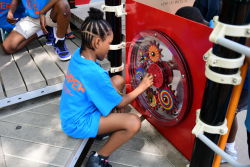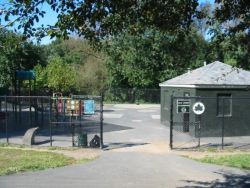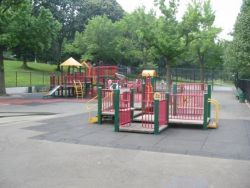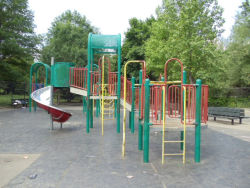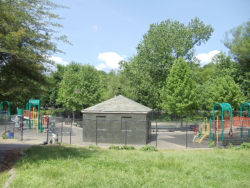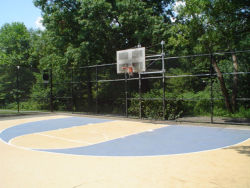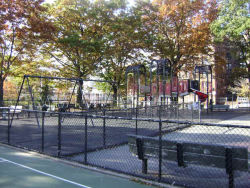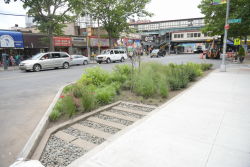Bronx River Parkway
The Daily Plant : Wednesday, January 16, 2002
NRG AND THE BRONX RIVER REVIVAL
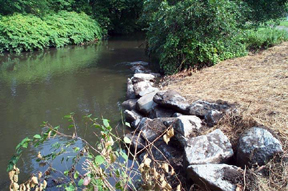
In January 2000, the National Oceanic and Atmospheric Administration (NOAA) gave the Natural Resources Group (NRG) nearly $191,000 to restore the one-and-a-quarter-mile segment of the Bronx River that flows through the "shoelace" section of Bronx Park. Dubbed "shoelace" for its long, narrow shape, this slender segment of Bronx Park is home to what was once a naturally meandering channel before the construction of the Bronx River Parkway, the Harlem Railroad, and Bronx Boulevard at the turn of the century. The straightening of the Bronx River resulted in a wider, shallower channel with little variation in depth and water speeds. Such conditions have limited the river’s capacity to respond to upstream impacts such as flood flows and increased sedimentation, and have resulted in decreased water quality, parkland erosion, the endangerment of existing trees, and fewer habitats for invertebrates, fish, and birds. Exacerbating riverbank erosion, the non-native and invasive Japanese knotweed (Polygonum cuspidatum) has taken the place of stable bank vegetation. The knotweed, which can grow to be over six feet tall, has benefited from high sediment loads in the river and strongly established itself on the banks. Unlike the woody and herbaceous vegetation that once inhabited the river’s banks, the knotweed’s shallow roots do little to hold the soil in place. In the spring, NRG began implementing various bioengineering techniques to combat the cumulative ecological problems facing the Bronx River. To extend and stabilize the toe of the banks, NRG foresters, field technicians, and Bronx River Alliance crew members installed over 3,300 feet of coir logs, a natural and biodegradable log made out of coconut fiber. Native woody and herbaceous vegetation was heavily planted in the logs, and as the logs decompose, the plants’ roots will begin to stabilize the riverbanks. In shade-free areas, the team used a technique called brush-layering to install multiple-log terraces planted with thousands of woody cuttings. In an attempt to restore full and healthy stands of trees to the east bank of the river, team members planted trees and shrubs, including pussy willow (Salix discolor), silver maple (Acer saccharinum), silky dogwood (Cornus amomum), red-osier dogwood (Cornus stolonifera), and others. As these terraces were installed, Japanese knotweed was cleared, and the dense plantings should preclude its return in future seasons. NRG also constructed four boulder-vanes (pictured above) to enhance wildlife habitat, direct flow to the center of the channel, impede the widening of the river, and improve water quality both at the site and downstream. These rocky structures will promote sedimentation in distinct areas rather than across the entire channel. Increased variability in bed forms along the river will result in more refuge for insects and fish. The boulder-vanes have already begun to attract a diverse community of animals, including fish, dragonflies, crayfish, and mallards (Anas platyrhynchos). Neighborhood residents, too, have begun using the rock vanes as natural, stable access points to the river. So far, NRG has planted 7,379 herbaceous plants, 3,500 woody cuttings, and 1,882 woody plants. This coming year, NRG plans to add more vegetation and to install a crib wall to prevent erosion in a near-vertical section of the riverbank. NRG will work with volunteers and interns from the New York City Environmental Justice Alliance (NYCEJA) to combat river erosion. Working with the Bronx River Alliance, NRG will monitor water quality and sample invertebrate populations to determine the success of the restoration. These investigations will also provide educational and volunteer opportunities for students and community groups, including the Youth Ministries for Peace and Justice, the Point Community Development Corporation, and Rock the Boat. For information on how to volunteer, please call (212) 360-1413. By David (Gorges) Kaplan
CORRECTION
Yesterday’s Daily Plant failed to deliver a birthday greeting to Recreation Analyst Jonathan (Nautilus) Ells, born today.
THIRTEEN YEARS AGO IN THE PLANT
(Wednesday, January 25, 1989)
THE YEAR IN REVIEW: MANAGEMENT & BUDGET II
Parks’ Management & Budget division was so busy in 1988 that it has taken two day’s worth of Daily Plant reporting to include all of their accomplishments.
- Recruitment is also rigorously screening the CPW applications and reaching out to communities where Parks has not traditionally recruited. These efforts upgraded the CPW applicant pool.
QUOTATION FOR THE DAY
It is the longest river in the world
– four thousand three hundred miles….
It is also the crookedest river in the world, since in one
part of its journey
it uses up one thousand three hundred miles to cover the same ground
that the crow would fly in six hundred and seventy-five.
Mark Twain
Life on the Mississippi (1883)


